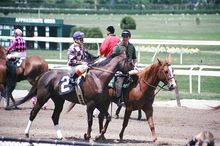In the Equine Disease Quarterly for January 2018, Michael “Mick” Peterson, PhD, University of Kentucky, addresses the risks of musculoskeletal disease and injury in performance horses as it relates to the types of surfaces on which horses compete.

A horse race track
To minimize risk and support required bone development in training, further research is needed to better understand the effects of surfaces on performance and injuries of the athletic horse.
© 2018 by Wikipedia - Dave Mock
The surface is one of the most common factors cited when an unexpected injury occurs with a performance horse. While the importance of surfaces can easily be overstated, unlike many other risk factors, surfaces impact every horse which competes at a venue.
Epidemiological research also shows that the type of surface, dirt, turf, or wax-coated sand, has a statistically significant effect on injuries even when other factors are considered.
The mechanism responsible for the effect of surfaces on musculoskeletal disease is well established. The skeleton of the horse adapts to the dynamic loading of the bone.
To minimize excess structure and to provide sufficient bone in highly loaded regions, bone is absorbed and deposited. The remodeling process produces a skeleton that is adapted to the training of the horse. Building the optimal skeleton requires that the horse performs the specified task during training.
The type of loading during training should match the expected loading during competition. However, the maximum performance may not be desirable during training; for example, the training distance may be shorter or the jumps lower.
The overall loading directions should match that expected in competition and depends not only on activity but also on the manner in which the surface supports the horizontal and vertical loading by the horse.
Both the load rate and the magnitude of loading is critical to bone remodeling and the risk of fracture. Surfaces must also provide appropriate footing during all phases of the gait. Consider the initial loading on the leading foreleg of a horse at a gallop to illustrate the demands.
During the initial impact of the hoof the loads are low, but the impact of the hoof on the surface occurs at a high speed. The loading, or firmness of the surface, primarily affects the peripheral bones in the leg. The smaller bones that have adapted to maximize the efficiency of the horse are quite susceptible to damage.
During the secondary loading, the dynamic weight of the horse is transferred to the leg and long bones of the horse are then loaded. The cushioning of the surface reduces the rate of loading of the bones and the risk to the more proximal bones of the leg.
While more research is needed, it is likely that both the training and competition surface should have optimal cushioning and firmness to ensure proper development of the skeleton while reducing the risk of injury.
In addition to these two factors, cushioning and firmness, three additional characteristics have been developed to characterize the surface response for equestrian competitions, namely responsiveness, grip, and uniformity.
To minimize risk during competition and to support required bone development in training, further research is needed to better understand the effects of surfaces on performance and injuries of the athletic horse.
In the interim, the current state of knowledge has been reviewed in white papers for racing and equestrian sports. Improved processes for the testing and approval of surfaces such as those under development by the International Federation for Equestrian Sports (FEI) show great promise for implementing current knowledge in a way that best protects both horse and rider.
Improvements in surfaces along with many other industry efforts have led to some of the recent reductions in catastrophic injuries in race horses, a critical effort for the protection of the racing industry as well as all equestrian sports.
